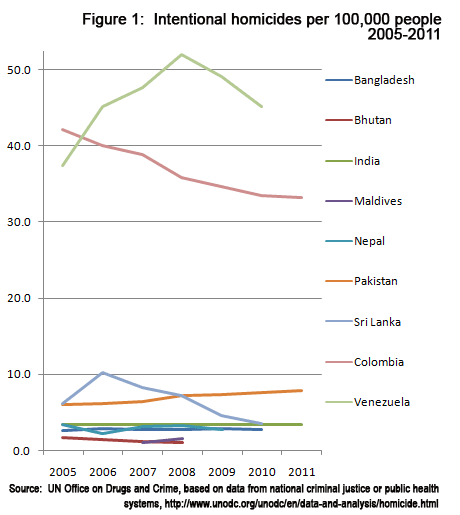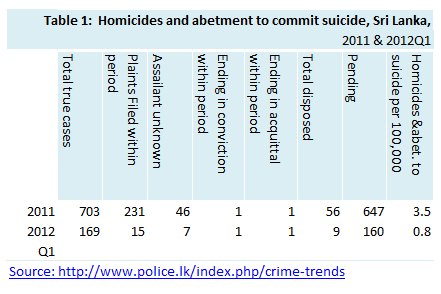Feb 06, 2014 (LBO) Each violent death is one too many. When it is senseless, when the victim is innocent,young and full of potential it hurts even more. When the victim is like us, we empathize.
The phenomenon looks large and frightening. We feel we are in the midst of carnage. We perceive a collapse of law and order. We fear hordes at the door.
I am still in mourning for Mel Gunasekera, senselessly killed in the prime of her life. But in the spirit of the fact-based journalism she practiced, I looked at the numbers. The United Nations Office on Drugs and Crimes conducted a Global Study on Homicide in 2011 (
http://www.unodc.org/unodc/en/data-and-analysis/homicide.html) that provides a good source of comparative data.
What the data tell
I took Colombia and Venezuela, the most violent countries in the most violent continent, South America, for reference and looked at the seven South Asian countries for which adequate data was available (Afghanistan and Iran excluded for lack of data).

We do not have comparable international data for Sri Lanka for 2011, 2012 and 2013. The Sri Lanka Police Grave Crime Abstract for 2011 and 2012Q1 (
http://www.police.lk/index.php/crime-trends) allows us to fill that gap. The category is homicides and abetment to commit suicide.

The 2011 homicide rate seems in line with the 2006-2010trend, stabilizing at around that of India. The 2012 1st Quarter numbers also seem in line with the trend, with the annual rate likely to be in the 3.5 percent range. A different source,
http://www.gov.lk/web/images/opendata/crime_data_2012.pdf, gives the total number of homicides and abetment of suicide as 645, about the same as 2011.
The data does show that the wheels of justice grind slow in Sri Lanka, with the great majority of cases pending at the end of the year (92 percent in 2011; the Police site tells us exactly where they are stuck). The percentage of dead-end cases (assailant unknown) are quite low (6.5 percent in 2011 and 4.1 percent in 2012Q1), contrary to the perception of many.
I was surprised by what the data told me (that is one reason I like looking at data). There is a widespread perception in our country that law and order is in tatters and that the Police are inept. It is wrong; it is not supported by evidence.
The time we should have been crying for remedial action was back in 2006, when Sri Lanka was the murder capital of South Asia. But in the same way that one does not feel a headache when one's legs are being broken, I guess we did not feel the spike in homicides in the year the LTTE initiated Eelam War IV by closing the anicut in Mavilaru and the five students playing by the beach were killed in Trincomalee.
What is to be done
Can we be happy with 3.5 homicides per 100,000 people? Definitely not. If we wish to live up to the name of Dharmadvipa, we must aim to reach the rates found in many European countries of below two homicides per 100,000 people and strive to be least violent country in South Asia (excluding the micro states). Even that would be too many, but we must be realistic in setting public-policy goals.
Let us do what we as citizens can and must do to keep crime down in our neighborhoods and in our country. That should not be limited to exerting pressure on the Police and the government, preferably based on evidence, to apply the law without fear and favor.
It also includes action in the places we live and work, to ensure safety for all. These actions would include community watch or eyes-on-the-street schemes, ensuring adequate lighting in public spaces (ViharaMaha Devi Park being a shining example), and perhaps even more CCTV cameras (the ones in Mel Gunasekera's neighborhood were invaluable in finding her killer within hours) for the deterrent effect, more than for the evidence.
We must go beyond repeating "Panatipataveramanisikkhapadamsamadiyami" mindlessly, to taking the actions that lead to adherence, including the controlling of greed and rage. Needless to say, parents and teachers have a critical role to play in the long-term task of building a non-violent society.
The government cannot by itself bring the homicide rate down from the present 3.5 per 100,000 people. We, the citizens, must also contribute.
Rohan Samarajiva heads LirneAsia, a regional think tank. He was also a former telecoms regulator in Sri Lanka. To read previous columns go to LBOs main navigation panel and click on the 'Choices' category.  We do not have comparable international data for Sri Lanka for 2011, 2012 and 2013. The Sri Lanka Police Grave Crime Abstract for 2011 and 2012Q1 (http://www.police.lk/index.php/crime-trends) allows us to fill that gap. The category is homicides and abetment to commit suicide.
We do not have comparable international data for Sri Lanka for 2011, 2012 and 2013. The Sri Lanka Police Grave Crime Abstract for 2011 and 2012Q1 (http://www.police.lk/index.php/crime-trends) allows us to fill that gap. The category is homicides and abetment to commit suicide.
 The 2011 homicide rate seems in line with the 2006-2010trend, stabilizing at around that of India. The 2012 1st Quarter numbers also seem in line with the trend, with the annual rate likely to be in the 3.5 percent range. A different source, http://www.gov.lk/web/images/opendata/crime_data_2012.pdf, gives the total number of homicides and abetment of suicide as 645, about the same as 2011.
The data does show that the wheels of justice grind slow in Sri Lanka, with the great majority of cases pending at the end of the year (92 percent in 2011; the Police site tells us exactly where they are stuck). The percentage of dead-end cases (assailant unknown) are quite low (6.5 percent in 2011 and 4.1 percent in 2012Q1), contrary to the perception of many.
I was surprised by what the data told me (that is one reason I like looking at data). There is a widespread perception in our country that law and order is in tatters and that the Police are inept. It is wrong; it is not supported by evidence.
The time we should have been crying for remedial action was back in 2006, when Sri Lanka was the murder capital of South Asia. But in the same way that one does not feel a headache when one's legs are being broken, I guess we did not feel the spike in homicides in the year the LTTE initiated Eelam War IV by closing the anicut in Mavilaru and the five students playing by the beach were killed in Trincomalee.
What is to be done
Can we be happy with 3.5 homicides per 100,000 people? Definitely not. If we wish to live up to the name of Dharmadvipa, we must aim to reach the rates found in many European countries of below two homicides per 100,000 people and strive to be least violent country in South Asia (excluding the micro states). Even that would be too many, but we must be realistic in setting public-policy goals.
Let us do what we as citizens can and must do to keep crime down in our neighborhoods and in our country. That should not be limited to exerting pressure on the Police and the government, preferably based on evidence, to apply the law without fear and favor.
It also includes action in the places we live and work, to ensure safety for all. These actions would include community watch or eyes-on-the-street schemes, ensuring adequate lighting in public spaces (ViharaMaha Devi Park being a shining example), and perhaps even more CCTV cameras (the ones in Mel Gunasekera's neighborhood were invaluable in finding her killer within hours) for the deterrent effect, more than for the evidence.
We must go beyond repeating "Panatipataveramanisikkhapadamsamadiyami" mindlessly, to taking the actions that lead to adherence, including the controlling of greed and rage. Needless to say, parents and teachers have a critical role to play in the long-term task of building a non-violent society.
The government cannot by itself bring the homicide rate down from the present 3.5 per 100,000 people. We, the citizens, must also contribute.
Rohan Samarajiva heads LirneAsia, a regional think tank. He was also a former telecoms regulator in Sri Lanka. To read previous columns go to LBOs main navigation panel and click on the 'Choices' category.
The 2011 homicide rate seems in line with the 2006-2010trend, stabilizing at around that of India. The 2012 1st Quarter numbers also seem in line with the trend, with the annual rate likely to be in the 3.5 percent range. A different source, http://www.gov.lk/web/images/opendata/crime_data_2012.pdf, gives the total number of homicides and abetment of suicide as 645, about the same as 2011.
The data does show that the wheels of justice grind slow in Sri Lanka, with the great majority of cases pending at the end of the year (92 percent in 2011; the Police site tells us exactly where they are stuck). The percentage of dead-end cases (assailant unknown) are quite low (6.5 percent in 2011 and 4.1 percent in 2012Q1), contrary to the perception of many.
I was surprised by what the data told me (that is one reason I like looking at data). There is a widespread perception in our country that law and order is in tatters and that the Police are inept. It is wrong; it is not supported by evidence.
The time we should have been crying for remedial action was back in 2006, when Sri Lanka was the murder capital of South Asia. But in the same way that one does not feel a headache when one's legs are being broken, I guess we did not feel the spike in homicides in the year the LTTE initiated Eelam War IV by closing the anicut in Mavilaru and the five students playing by the beach were killed in Trincomalee.
What is to be done
Can we be happy with 3.5 homicides per 100,000 people? Definitely not. If we wish to live up to the name of Dharmadvipa, we must aim to reach the rates found in many European countries of below two homicides per 100,000 people and strive to be least violent country in South Asia (excluding the micro states). Even that would be too many, but we must be realistic in setting public-policy goals.
Let us do what we as citizens can and must do to keep crime down in our neighborhoods and in our country. That should not be limited to exerting pressure on the Police and the government, preferably based on evidence, to apply the law without fear and favor.
It also includes action in the places we live and work, to ensure safety for all. These actions would include community watch or eyes-on-the-street schemes, ensuring adequate lighting in public spaces (ViharaMaha Devi Park being a shining example), and perhaps even more CCTV cameras (the ones in Mel Gunasekera's neighborhood were invaluable in finding her killer within hours) for the deterrent effect, more than for the evidence.
We must go beyond repeating "Panatipataveramanisikkhapadamsamadiyami" mindlessly, to taking the actions that lead to adherence, including the controlling of greed and rage. Needless to say, parents and teachers have a critical role to play in the long-term task of building a non-violent society.
The government cannot by itself bring the homicide rate down from the present 3.5 per 100,000 people. We, the citizens, must also contribute.
Rohan Samarajiva heads LirneAsia, a regional think tank. He was also a former telecoms regulator in Sri Lanka. To read previous columns go to LBOs main navigation panel and click on the 'Choices' category. 